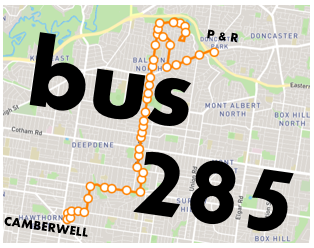If you wanted to catch it from Camberwell your first challenge is finding the stop. It's in a back street near a car park a bit away from the train and tram. On paper Camberwell is a significant interchange with trains, trams and limited buses. On the ground though it's different. Heritage-inclined locals are defensive of their crumbling and inefficient railway station and have foiled plans for its reconstruction and redevelopment into a modern transport interchange.
The route runs east for a bit, paralleling the Ringwood line. A potential train interchange point is Canterbury. However peak period train timetables are complex with numerous stopping patterns. Hence Canterbury sees a less consistently frequent service than Camberwell. Timetable reform could address this. There is also scope to improve physical interchange between trains and bus too.
The local bus network review covering Boroondara done about 12 years ago recommended simplifying the Balwyn North portion of the 285 but, like, most of its recommendations, was not proceeded with.
Timetable
Route 285 is a daytime only route operating six days per week. On weekdays it runs from approximately 7am to 6pm, meaning it doesn't fully cover both am and pm peak periods. The first morning arrival get to Camberwell a shade before 7am with the last departure around 6:30pm. The last weekday departure from the Doncaster end is earlier, being before 6pm. Services are every 45 minutes interpeak, meshing with both Ringwood line trains and buses at Park & Ride (every 15 min). Peak services are mostly every 30 minutes, with a 40 min am peak-of-peak gap towards Camberwell.
Saturday service is approximately hourly between about 8am and 6pm. Services run to the standard public holiday pattern, with a Saturday timetable operating on most public holidays. Like all but one other north-south bus in the area there is no Sunday service. This creates a gap of many kilometres where one must backtrack considerable distances to make even local trips.
Patronage
According to figures I've seen (late 2018) Route 285 usage is very low. 6 to 7 passenger boardings per hour. This makes it similar to grossly underperforming routes like the 280/2 'Manningham Mover'. My gut reaction would be to query that number since the 285 is the nearest bus for many. The nearby 284, for instance, is 3 or 4 times as busy on a passenger boardings per hour basis.
On the other hand the 285 bus has handicaps that would stymie its usage. These include the poor terminus location at Camberwell, not ideal stop locations at Canterbury, confusing route alignment in North Balwyn (including backtracking), the weak terminus at Park & Ride (as opposed to Shoppingtown) and the timetable that is unattractive for weekday commuters. The 45 minute off-peak frequency is not clockface, though we have dozens of routes operating every 40 minutes off-peak with good patronage. Another force working against the 285 is the area's high income catchment demographics that is generally negatively correlated with non-peak bus usage.
History
North-south routes in this area, including the 285, has not had serious reform for about 25 years. Before that, from at least the early '70s to the late '90s, the route ran from Camberwell to Balwyn North as the 731. BCSV has maps showing this. The 285 number was used at various times for Doncaster area routes in the 1970s and early 1990s but these are unrelated to the 285 discussed here.
The 731 can trace its history back to the 1930s. The 700-series route number likely came about because at the time of the big route renumbering in 1971 the route was run by Ventura. In the south and east the Ventura routes mostly got 700-series numbers while Grenda routes got 800-series numbers. Ex government tramways routes got 200 and 300 series numbers, with these moving to National Bus and Melbourne Bus Link following privatisation.
Transfers of bus routes between surviving operators are rare but not unknown. It can be advantageous to both companies if they result in routes being nearer their depots and/or more efficient scheduling. In 731's case this involved a transfer firstly from Ventura to Quince's in 1991 and then, when Quince's left the route bus game, to National Bus in 1998. National renumbered it to 285 when they extended it to Doncaster Shoppingtown later that year.
Later (2004) Ventura got it back when they bought the National Bus franchise. But this was only temporary; refranchising saw the National Bus network (along with Melbourne Bus Link and the SmartBus orbitals) go to Transdev in 2013. These services will go to winning bidder Kinetic next year.
Conclusion
The 285 may have significant potential despite its currently low patronage performance. It's the only bus on the Balwyn Rd corridor and, if more frequent, could provide a lot of local connections involving already frequent east-west routes. However its Balwyn North pocket is complex, its eastern terminus is weak and there are some issues with its interchange locations and service levels. These may have hampered usage. Comments on this are appreciated and can be left below.






1 comment:
Back in the '70s this was mainly a school service. It came close to the old Marcellin site in Canterbury Road, Close to Canterbury Girls HS, right to Fintona Girls School and close to Balwyn HS, also linking these schools to the swimming pool in Belmore Rd, Balwyn.I haven't travelled on it this century so can't report current usage.
Post a Comment